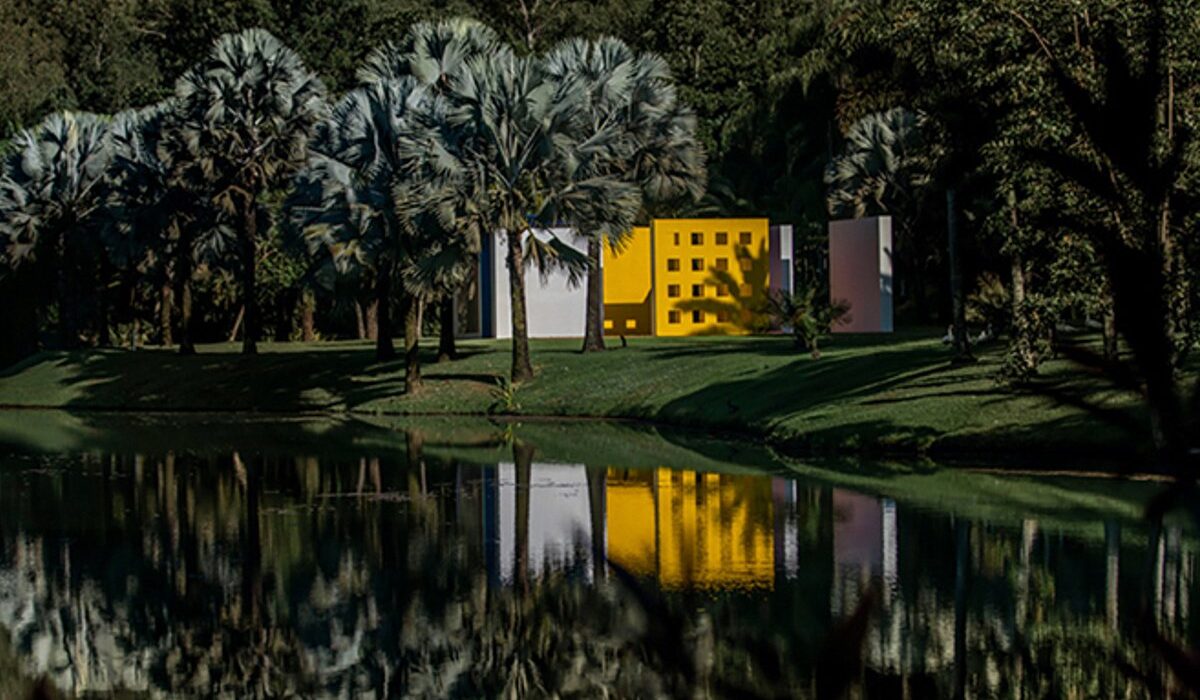Next year the Inhotim Institute in Brumadinho, Minas Gerais, will inaugurate an on-site hotel, marking the first phase of a megaproject involving the construction of several resorts linked to the art museum and botanical garden.
The 140-hectare institution on the outskirts of Belo Horizonte has experienced a significant rise in attendance since it opened to the public in 2006 and now sees around 5,000 visitors per day. Organisers expect attendance figures to continue rising, and have recorded 300,000 visitors this year so far, a nearly 40% increase from 2022. There are some contributing factors: over the summer, Inhotim unveiled a pavilion honouring Yayoi Kusama and featuring one of the artist’s popular Infinity Rooms, as well as a major indoor exhibition devoted to the seminal Brazilian artist Rubem Valentim. Next year, it plans to add ten new permanent installations.
The hotel project will be launched in three phases. First, with the completion of a 44-room hotel in late 2024, then with the construction of a separate 150-room hotel, due to be inaugurated in 2029, and finally with the construction of an off-site, 150-room hotel located less than one kilometre from Inhotim. Construction on the first phase resumed last year after a hiatus of nearly a decade due to lack of funds. The project regained momentum at a pivotal moment for Inhotim, as the institution works to restructure and expand following the departure of Bernardo Paz, the Brazilian art collector and mining tycoon who founded Inhotim in 2004 to house his personal collection. Inhotim later became embroiled in legal allegations against Paz, who was accused of transferring nearly $100m in donations made to Inhotim to his private steel and mining companies. Paz was charged with money laundering in 2017 but was acquitted in 2020, after which he gradually minimised his involvement with the institution.
Between 2021 and 2022, Paz—who previously funded 70% of Inhotim’s operational budget—donated Inhotim’s grounds, galleries, pavilions and 330 artworks to the institution. He owned the partially constructed hotel until earlier this year, when ownership was transferred to Clara Resorts, a São Paulo-based eco-resort group. He does not currently hold any stake in the forthcoming hotels. Paz also transferred stewardship of Inhotim to a team of well-known figures in the Brazilian and international art worlds, including Lucas Pessôa, the former finance and operations director of the São Paulo Museum of Art, who joined as the president and director; Paula Azevedo, the vice president and former director of institutional relations at the Tomie Ohtake Institute in São Paulo; and artistic director Julieta González, a curator with previous experience at the Tate Modern and other major museums.
“We organised our plan into three main pillars: renew and modernise Inhotim’s governance, incorporate Paz’s private collection and secure independent long-term funding for the institution,” he says. “All these initiatives are connected to the same idea of reinforcing the public mission of Inhotim—shifting from a private collection to an institution that is permeable and porous with a strong financial capacity to invest in its artistic programme.”
In addition to the establishment of a 30-member board of trustees, who are involved in the acquisition of new artworks and the development of new pavilions on the site, Inhotim’s number of corporate sponsors has increased from 18 to 35 companies.
This year, Inhotim also closed an $80m, ten-year sponsorship agreement with Vale, another private mining company based in Minas Gerais. With its $10m annual operating budget met for the foreseeable future, organisers are now working on developing an endowment fund, and there are plans to boost the centre’s educational offerings, which will be spearheaded by the artistic director Júlia Rebouças with Gleyce Heitor, who has been hired for the newly-created role of director of education.
Organisers are hopeful that the new hotels, alongside the institution’s other offerings, will have a ripple effect on tourism in the region and benefit the surrounding communities, which remain largely underdeveloped and gravely underprivileged. Most residents of the adjacent communities work in mining or agriculture, and nearly 50% of the nearby population lives under the poverty line.
“Despite being a private institution, we have the public mission of promoting an inclusive and diverse program, as well as fostering education, critical knowledge and social and economic development as key institutional goals,” Pessôa says. “We need to be a socially engaged museum in order to fulfil our role in current times. It doesn’t make sense to have this exuberant botanical garden and blue-chip art collection if we are unable to change the reality of those who live in our surrounding communities.”

